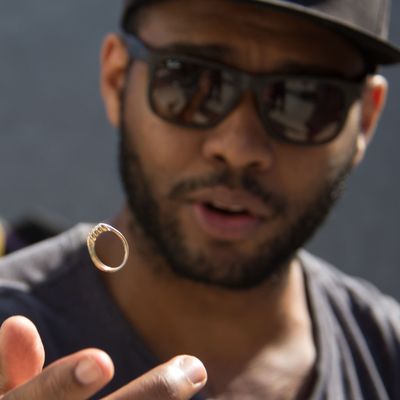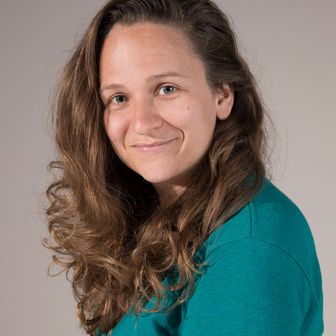
When I ask J.D. Dillard where he wants to meet for our interview, he suggests an outdoor café at the Los Angeles County Museum of Art. It’s a location that’s convenient for both of us — a prerequisite for a successful rendezvous in L.A.’s gummed-up concrete sprawl — but just as important, it offers tea. Dillard, a coffee drinker, has transitioned to tea in the afternoon because he’s taking so many meetings these days that the coffee is making him tweak out. “The second I have an office, my caffeine addiction will stop because it’s solely generated from going, having meetings, getting a coffee,” he says. “Any other [interview locations] I would have to get a coffee, and then I would’ve done that three times already today. I would have been psychotic talking to you.”
On this sunny afternoon in April, though, Dillard is far from psychotic. As we talk in the museum’s quiet courtyard, the young filmmaker is friendly and relaxed. He seems like a genuinely kind person who has also gotten very good at making strangers in the press feel like friends. When you’re shepherding your first feature toward its theatrical release, that’s a good skill to have.
Dillard’s Sleight premiered at the 2016 Sundance Film Festival, but it’s something of a Sundance oddity: a family drama about a teenage magician who works for a drug dealer, and that verges into sci-fi at times. It’s a broader concept than you usually find at the festival; the movie feels like a YA adaptation, even though it’s an original script. Still, the film was warmly received in Park City, and was quickly snatched up by genre specialist Blumhouse.
Getting that Sundance buzz meant Dillard started fielding pitches from newly interested parties, and given his race, many of those potential projects had familiar loglines. “The material that was popping up was obviously very knee-jerk. Like, ‘Would you like to tell the first black firefighter movie?’ Hmm, not exactly,” he says. While Dillard finds movies like Moonlight and Selma essential, his focus is currently on the playful, boundary-pushing environs of genre cinema, horror, and science fiction. He cites last year’s fantastical character study The Fits as one of his favorite recent films. “In terms of my own interests and how I want to contribute to the diversity conversation, at this stage it’s not necessarily with slave movies and civil rights–adjacent stories,” he says. “I come from the genre space. That’s what I love. I do want to tell stories that center on women and/or people of color. I would love to give a young Asian woman a role that otherwise could have just gone to some white dude. To me, that’s the beauty of genre. You get to sugarcoat things. Just by having, ‘Look, it takes place on a spaceship,’ people will be like, ‘I’ll go see that, even though there are black people in it.’”
Dillard’s own origin story is the kind that makes you believe in the dream Hollywood sells you. A young guy who grew up loving the populist, heartfelt stories of Steven Spielberg moves to L.A. and gets a job as a receptionist at Bad Robot, the powerhouse genre studio founded by J.J. Abrams. Dillard, who has a Star Wars tattoo, became close enough with Abrams and his family to start working for them. Even after Dillard left his job at Bad Robot to pursue writing full-time, Abrams asked him to move to Europe for a few months to serve in a general support role during production on The Force Awakens. (Dillard told the Frame the gig included tutoring the Abrams children.) Emboldened by watching one of the biggest sci-fi films of all time come together, Dillard returned to the States dead-set on getting a movie made. He and his writing partner, Alex Theurer, had made a short film about a teenage magician and street hustler, and producers at Diablo Entertainment agreed to fund a feature version. A few months later they started shooting with an unknown lead on a low-six-figure budget; now, just under two years later, Sleight is about to open nationwide.
Dillard’s debut may not change the world, but it’s a fine example of the kind of movies Hollywood could use more of: It’s cheap and utterly likable, based on an original idea, with strong visuals and a cast comprised almost entirely of nonwhite actors. It’s also the exact kind of high-potential project that Blumhouse has demonstrated an aptitude for nosing out, which is probably why the studio has already signed on for a second go-round with Dillard.
The director won’t share many details yet, besides the fact that the film, Sweetheart, is a “horror-survival story” set to star Kiersey Clemons and Emory Cohen. One of Dillard’s goals is to deconstruct the idea that hiring white people classifies as “traditional casting.” He wants to normalize onscreen diversity by hiring people of color in roles that don’t have anything to do with their racial narrative. In the case of Clemons — the rare black woman leading a horror film — that meant writing a character his two younger sisters could relate to.
Like his influences Spielberg and Abrams, Dillard wants audiences of every background to feel seen in his movies, but the fact that viewers of color so rarely get that option means he’s working a little harder for them. “The kids who I really want love Sleight, I know they look up to J. Cole. I know they look up to Big Sean. So there’s this thing in my head where part of my responsibility is to command a similar image. If a 13-year-old black kid sees me in a magazine, it’s like, Oh, he’s not a rapper, but makes movies? I didn’t know people like me made movies,” he says. “I do feel some responsibility as we keep going down this road to do that. But again, this all started yesterday. I don’t know what’s going on. Help. What’s happening? Where am I?”
Another reason the director might be taking so many coffee meetings lately is because he’s reportedly in talks to direct a reboot of The Fly for Fox. When discussing Sweetheart, Dillard says he is “grateful” to not be making the leap to a massive studio picture for his second movie, but also admits he wouldn’t turn his back if the signal went up. “Trust me, if anybody showed up and was like, ‘You wanna do Jurassic Park?’ I’d be like, ‘Of course I do,’” he explains. His dream film would be a combination of “spectacle and scale” that also leaves you sobbing. “From The Fits to Force Awakens. I love everything in between, but like, if I could just have the grit of Sicario and the scale of Star Wars and then the dramatic heartbreaking feels of Beginners, I would be on cloud nine.”
It turns out Dillard’s bit about waiting for an office to fully tamp down his coffee habit was only a half-truth. He has one now at the Blumhouse headquarters in L.A., complete with a little paper sign on the door that says “Sweetheart” in black marker. But it’s a little cozy for regular meetings; he’s sharing the space with three other people. If The Fly deal morphs from a rumor to a reality, Dillard will be helming one of the most iconic properties in sci-fi history, and he’ll likely have a big, posh desk at which to sip tea and take meetings. Or he might stay on the Blumhouse path and be hammering away on the next maybe-this-will-be-huge million-dollar surprise. Either way, he’ll be ready for the challenge, freshly caffeinated. “Everything right now is talk and conjecture,” he says. “So, if something like [The Fly] became the next thing, cool. If I shoot a movie for $2 million that takes place in a cellar, it will be dope.”





